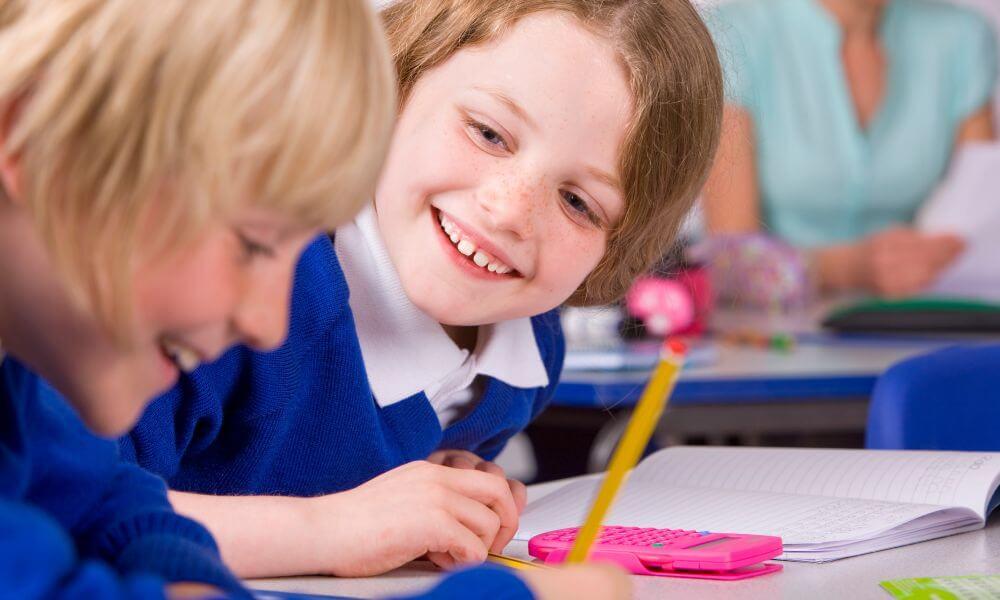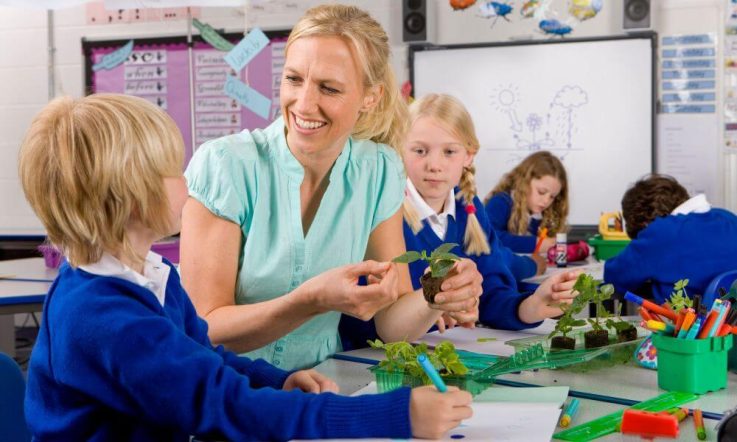Global results from the 2023 Trends in International Mathematics and Science Study (TIMSS) have just been released. Analysis of Australia’s performance, carried out by the Australian Council for Educational Research (ACER), show year 4 students achieved the country’s best-ever result in the international assessment.
In our latest expert Q&A we’re joined by ACER Senior Research Fellow and lead author of the TIMSS 2023 Australia Volume I report Nicole Wernert to discuss the main takeaways, and what the data say about year 4 and 8 student strengths and weaknesses in the different content domains.
What is TIMSS and why is it an important measure, internationally?
TIMSS is an international assessment of maths and science at years 4 and 8 that is based on curricula, so it’s particularly useful to countries in assessing what students know and can do in their context.
To ensure that comparisons between countries are as fair as possible, TIMSS begins with a detailed analysis of national year 4 and year 8 mathematics and science curricula and then tests the key skills and knowledge that participating countries have agreed should be achieved at those year levels. This highlights strengths and areas for improvement. And because it’s been running since 1995 and monitors trends over time, TIMSS also provides insights into whether any changes made in an education system are having an impact.
Around 656,000 students from 64 countries and economies, including 13,912 Australian students from 559 schools, participated in TIMSS 2023. These students completed an online test and questionnaire. In the test, there was a range of response formats, including multiple-choice questions and open-constructed questions, where students had to provide a written response. There were also interactive items where, for example, students could replicate a science experiment in a series of animated on-screen activities. In the questionnaire, students were asked about their family background and their attitudes towards learning maths and science.
School principals and the teachers of the participating students were also involved in TIMSS. They completed an online questionnaire that asked about school characteristics, the quality of the school’s teaching and educational resources, teacher training, teacher professional development, instructional practices and school and classroom climate.
The latest results have just been published – what are the main takeaways for Australia?
Australian year 4 students have achieved our best-ever result, in both science and maths. This is really impressive considering their first years of schooling occurred during the COVID-19 pandemic.
Australian year 4 students are performing within the top 10 participating countries in year 4 science, with only 4 countries (Singapore, Korea, Chinese Taipei and Türkiye) performing at a significantly higher level.
The year 4 maths result was also an improvement on the previous cycle, with the number of countries outperforming Australian students dropping from 22 to 14.
Year 8 students have maintained the achievement levels set in previous years, with similar results to those recorded in 2019. Considering they would have been in critical transition years from primary to secondary during COVID, this is not a bad result.
For context, only 3 countries improved in each of year 8 maths (Romania, Sweden and the United Arab Emirates) and year 8 science (England, Hong Kong and the United Arab Emirates) since 2019.
What does the analysis tell us about the possible drivers for Australia’s improvement?
A lot of Australia’s improvement at year 4 was due to a significant increase in the percentage of very high performing students. These are students who perform at advanced levels for their year level.
TIMSS uses benchmarks to identify what students can do at different levels of achievement. The very high performing students are those that achieved the Advanced International Benchmark. In year 4 science this means that they can 'show, apply, and communicate their knowledge of life, physical, and Earth sciences, and engage in multiple scientific inquiry practices'. For example, very high performers show that they know about changes in states of matter and can reason about dissolving rates in a laboratory setting.
This is in contrast to those performing at the International Intermediate Benchmark (which, in Australia, is considered the National Proficient Standard – a challenging but reasonable level of achievement). Year 4 students achieving at the International Intermediate Benchmark ‘show and apply knowledge of some scientific concepts’. For example, they show knowledge about properties of matter, and can relate observations and data to scientific facts.
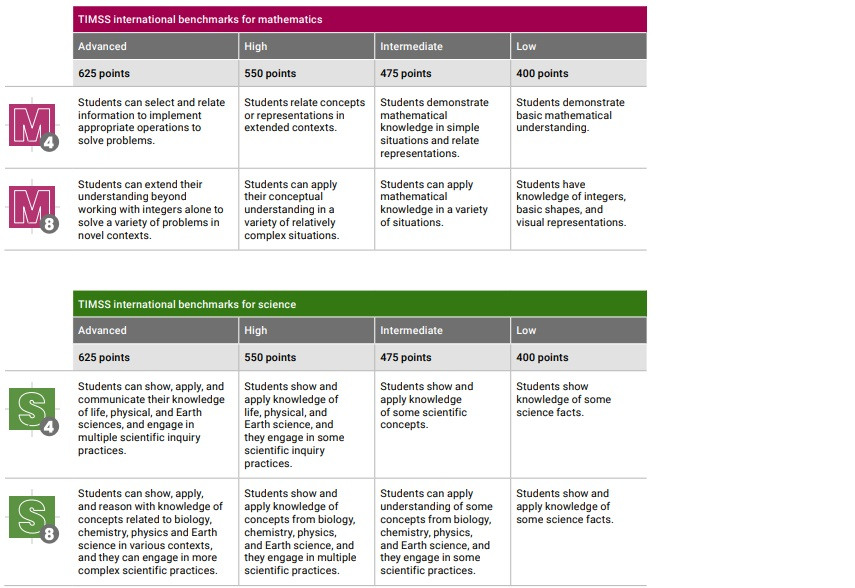
In terms of the content domains, analysis of the Australian results also gives important insight into the relative strengths and weaknesses of students. What is the data saying for science?
TIMSS has a focus on the content covered in school curricula. The TIMSS Science Assessment Framework covers 3 content domains at year 4 – Life science, Physical science and Earth science – and 4 content domains at year 8 – Biology, Chemistry, Physics and Earth Science.
The topics covered by these domains include:
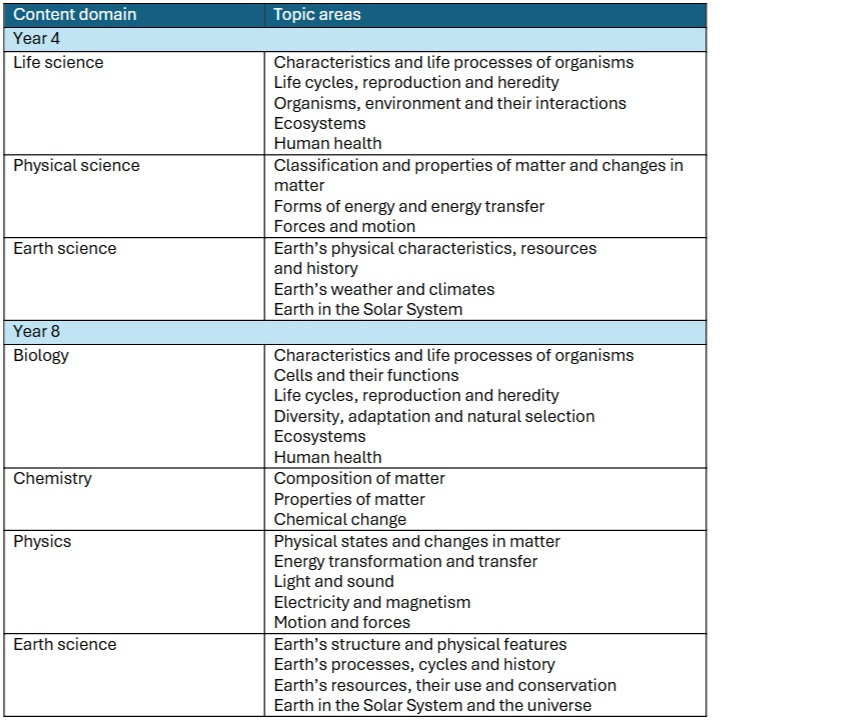
Students in year 4 showed similar results in the Life and Earth sciences, but they were weaker in Physical Science. An example year 4 Physical science item asks students to identify which of 6 objects can be picked up using a magnet. This is an example of an item at the International Intermediate Benchmark.
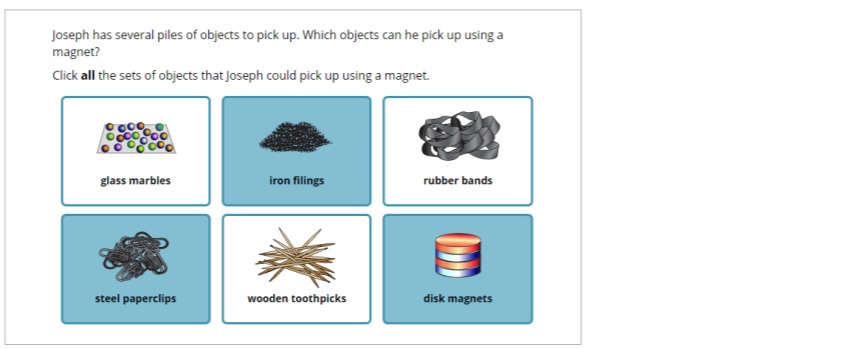
In year 8 students were stronger in Physics and Earth science than they were in Biology and Chemistry.
And what are the content strengths and weaknesses for year 4 and 8 students in mathematics?
The TIMSS Mathematics Assessment Framework covers 3 content domains at year 4 – Number, Measurement and geometry, and Data – and 4 content domains at year 8 – Number, Algebra, Geometry and measurement, and Data and probability.
The topics covered by these domains include:
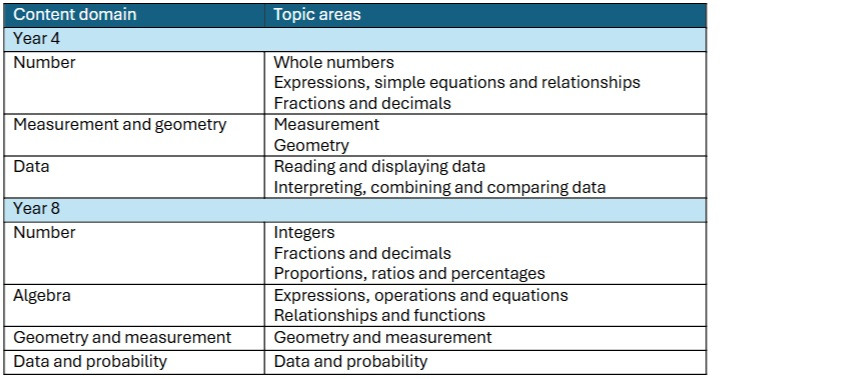
Year 4 students were stronger in Data and weaker in Number, and showed a similar skill level in Measurement and geometry.
In year 8, they were stronger in Data and probability and weaker in Number and Algebra, and showed similar levels of skill in Geometry and measurement.
We’ve found from previous TIMSS cycles that Australian students are often stronger in the Data and probability items. An example year 4 Data item asks students to work out missing values in a table. This is an example of an item at the International Intermediate Benchmark.
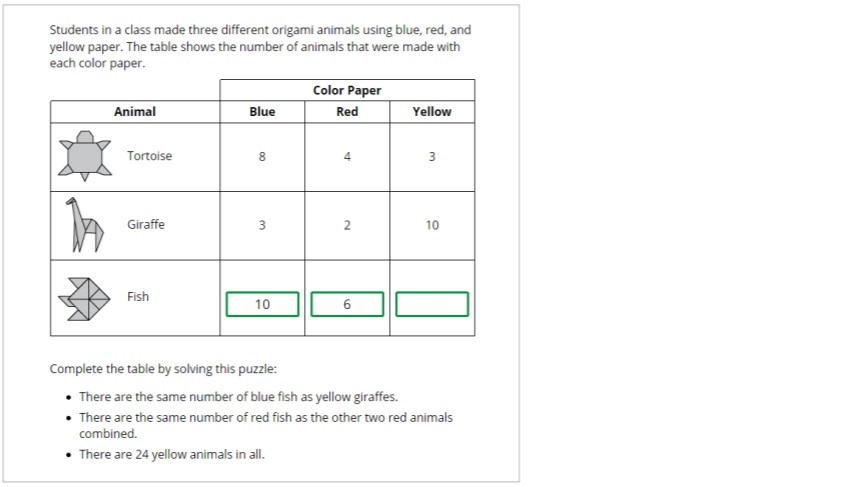
There’s also data on student strengths and weaknesses in relation to the cognitive domains – knowing, applying and reasoning.
TIMSS also categorises the items by the cognitive skills that they are assessing:
- Knowing – the facts, concepts and procedures students need to know
- Applying – the ability of students to apply knowledge and conceptual understanding in a range of situations
- Reasoning – involves the logical, systematic thinking that students need to use to generate and justify solutions to problems, make inferences, and deal with complex relationships between mathematical objects
To find these strengths and weaknesses, we compare the overall maths score for the average student with the scores the average student achieved in the cognitive domains.
In maths, year 4 students were stronger in knowing, and weaker in applying, with no significant difference in reasoning. The Data item provided above was an example of an item that was drawing on the cognitive skill of applying.
In year 8, students were, on average, weaker in reasoning, with no significant difference in knowing or applying. A mathematics item that drew on the skill of reasoning would be one that might require the student to explain their answer, such as this Algebra item.

In year 4 Science, there were no significant score differences between any of the cognitive domains and the overall maths score.
For year 8 students, we found they were stronger in reasoning, weaker in knowing, and not significantly different in applying.
What would you expect to see in the next cycle of TIMSS in 2027 based on these results?
The year 4 group from 2023 will be in year 8 in 2027, so I really hope to see the improvement in Australia’s year 4 TIMSS results flow through to year 8 in the next TIMSS cycle.
In 2027 we might also be able to gauge the impact of version 9 of the Australian Curriculum on maths and science learning for these age groups. With each state or territory guiding schools on implementing or adapting, or adopting into their own curriculum from 2023, there will be a lot to reflect on for those who have had reforms in place for a number of years.
In the meantime, we’ll now turn our attention to analysing the student, teacher and principal questionnaire responses. This gives us a lot of insight as to what might be influencing our achievement data.
For example, in the last TIMSS assessment, we found that an important factor behind Australia’s year 4 maths achievement may be the comparatively low proportion of Australian students who begin primary school with foundational literacy and numeracy skills. So that’s something I’ll be very interested in monitoring.
Volume II of the Australian results is due to be released by ACER in April. In the meantime, stay tuned for more articles, infographics, podcasts and videos over the coming months as we unpack the TIMSS 2023 results and share insights for your own context and classroom practice.
References
Wernert, S., Schmid, M., & Rodrigues, S. (2024a). TIMSS 2023 Australia. Volume I: Student performance. Australian Council for Educational Research. https://doi.org/10.37517/978-1-74286-755-7
Wernert, N., Schmid, M., & Rodrigues, S. (2024b). TIMSS 2023 Australia: Highlights on Australian student performance. Australian Council for Educational Research. https://doi.org/10.37517/978-1-74286-757-1
TIMSS is directed by the International Association for the Evaluation of Educational Achievement (IEA). ACER manages the implementation and reporting of TIMSS in Australia on behalf of the Commonwealth, state and territory governments. To find out more about Australia's performance in TIMSS and access all the reports and data from this and previous cycles visit https://www.acer.org/au/timss
